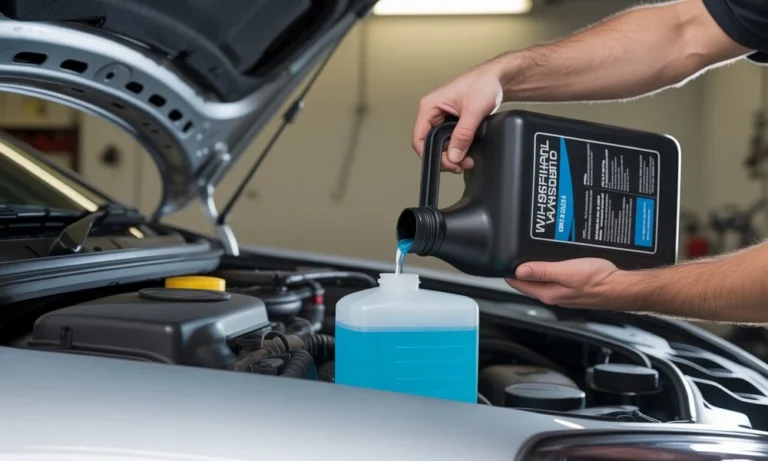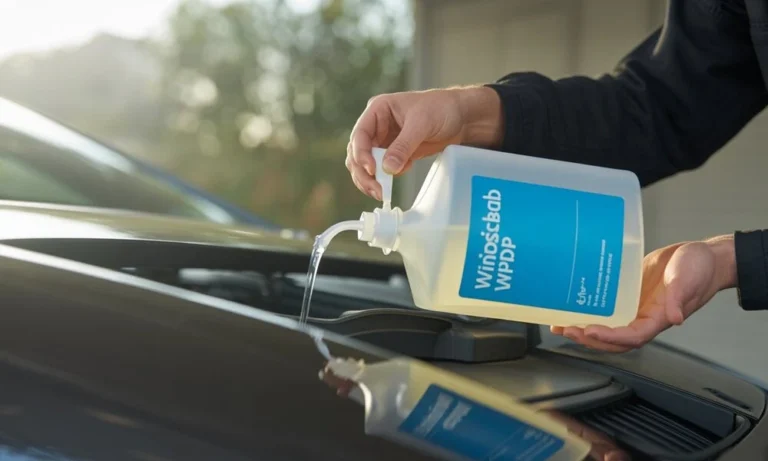How To Refill Windshield Wiper Fluid
How to refill windshield wiper fluid is a simple but essential skill every car owner should know. The fluid for windshield wipers plays a critical role in maintaining clear visibility by removing dirt, debris, and grime from your windshield. Without it, driving in dusty or rainy conditions can become dangerous. Most people find themselves needing to refill washer fluid when the dashboard warning light comes on, visibility worsens, or the wipers start to drag across the glass.
Changes in seasons, especially winter and pollen-heavy spring, often lead to more frequent use of wiper fluid. In this article, we’ll cover everything you need to know: how to refill windshield wiper fluid, where to find the reservoir in your vehicle, and whether alternatives like water are safe or recommended.
What is Windshield Wiper Fluid and Why It Matters

When it comes to vehicle maintenance, most drivers remember the big-ticket items like oil changes or tire rotations. But something as simple as windshield wiper fluid plays a critical role in your safety on the road. Clean, unobstructed visibility is vital for safe driving, and that’s exactly where windshield wiper fluid comes in.
The Role of Wiper Fluid in Vehicle Maintenance
Windshield wiper fluid is a specially formulated solution used to clean your vehicle’s windshield. It’s dispensed through small nozzles onto the glass and wiped clean by your wipers. This may seem like a minor feature, but its role in vehicle maintenance is more important than many realize.
Without regular windshield wiper fluid refills, dirt, grime, bird droppings, bugs, and road salt can accumulate on your windshield, reducing visibility and potentially leading to dangerous driving conditions. A clean windshield also helps extend the life of your wiper blades and prevents scratches that can occur when wiping dry or dirty glass.
Different Types of Wiper Fluids
Choosing the right wiper fluid depends on your driving environment and the season:
- Summer Formula: Designed to remove bug splatter, road tar, and general dirt. These fluids often contain detergents that cut through grime.
- Winter Formula: Contains antifreeze agents like methanol or ethylene glycol to prevent freezing in cold temperatures and help remove road salt and ice.
- Bug Remover Fluid: Enhanced with special cleaners to break down bug residue that’s harder to remove with standard formulas.
- All-Season Blends: A versatile option that works well in most weather conditions.
No matter the type, making sure your vehicle has a regular windshield wiper fluid refill ensures you’re prepared for changing road conditions.
Safety and Visibility Benefits
A clean windshield is essential for safe driving, especially during rainstorms, snow, or dusty conditions. Without effective wiper fluid, your wipers can smear dirt across your windshield rather than remove it, significantly impairing your view.
Refilling your windshield wiper fluid isn’t just about cleanliness—it’s about driver and passenger safety. Poor visibility is a leading cause of accidents, and something as basic as a windshield wiper fluid refill can be the difference between a clear view and a dangerous blind spot.
You can read about Is Windshield Wiper Fluid Flammable.
Where to Put Windshield Wiper Fluid: A Step-by-Step Guide
If you’ve ever found yourself with a dry windshield or streaky wipers, it may be time for a refill washer fluid. But before you grab a bottle of fluid, it’s important to know where to put windshield wiper fluid to ensure it’s going into the right place.
One minor but crucial aspect of regular auto maintenance is knowing how to correctly refill your washer fluid. Here’s a simple guide to help you locate the windshield washer fluid reservoir and ensure you’re filling it up correctly.
Step-by-Step Directions to Locate the Reservoir
- Open the Hood of Your Vehicle
Opening your car’s hood is the first step. Locate the hood release latch, which is often found close to the footwell on the driver’s side of the car. After releasing it, raise the hood and use the prop rod to secure it, if needed. - Locate the Windshield Wiper Fluid Reservoir
The windshield wiper fluid reservoir is typically located near the engine, near the back of the engine bay. It’s often to the side of the car, close to the windshield, for easy access. In many vehicles, the reservoir is situated on the driver’s side. - Identify the Cap with the Windshield/Wiper Symbol
Most vehicles have a clear, plastic reservoir that is easy to spot. Look for a cap with a symbol that resembles a windshield with water splashing on it. This symbol is usually marked in blue or black, making it easy to identify even for first-time users. The cap itself is often translucent, allowing you to see the level of fluid inside. - Unscrew the Cap
Once you locate the right cap, unscrew it. If your cap is tight or hard to remove, it may have a locking mechanism. Gently twist or pull to open it. - Add the Fluid
After removing the cap, you’re ready to refill washer fluid. Pour the fluid slowly into the reservoir. Most vehicles will have a “full” line inside the reservoir to show you the correct level. Don’t overfill it—leave a little space at the top to avoid spillage. - Secure the Cap
After adding the fluid, carefully replace the cap and ensure it’s securely fastened. You’re finished when you close the car’s hood!
Why It’s Important to Refill Washer Fluid
Properly maintaining your windshield wiper fluid reservoir is crucial for keeping your windshield clean and ensuring clear visibility while driving. During heavy rain, winter months with road salt, or even after a dusty drive, a refill washer fluid can make a huge difference in your ability to see the road clearly.
If you neglect to refill washer fluid, your wipers could end up streaking dirt and debris across the glass, further obstructing your view. Additionally, running low on wiper fluid could damage your wiper pump, which is costly to repair.
How to Refill Windshield Wiper Fluid in Easy Steps

Refilling your windshield wiper fluid is a simple but important task in vehicle maintenance. Having enough fluid for windshield wipers ensures that your windshield remains clean and clear for safe driving. If you’re not sure how to properly refill windshield wiper fluid, follow these easy steps to get the job done.
1. What You Need
Before you start, make sure you have the following items:
- Windshield wiper fluid: You can find this fluid at most auto parts stores or online. Choose the appropriate type depending on the season (e.g., summer or winter formula).
- Funnel (optional but helpful): If you’re worried about spilling, a funnel will make pouring the fluid easier and cleaner.
2. Step-by-Step Process
1. Park the Vehicle and Let the Engine Cool
For safety reasons, always park your car on a flat surface and make sure the engine is off. Let the engine cool down for a few minutes before you begin. This will help prevent burns or discomfort when working under the hood.
2. Open the Hood and Find the Reservoir
To access the windshield wiper fluid reservoir, open the hood of your car. The hood latch is usually located inside the car near the driver’s seat, often near the footwell. Once open, locate the reservoir, which is usually near the back of the engine bay, on the driver’s side.
3. Check Fluid Level (If Visible)
Some reservoirs are made of transparent plastic, allowing you to see the current fluid level. If the fluid is low or empty, it’s definitely time to refill windshield wiper fluid. If the level isn’t visible, you may need to open the cap to check inside.
4. Open the Cap and Pour the Fluid In
Once you’ve located the reservoir, unscrew or lift the cap. Most caps are marked with a windshield/wiper symbol, so they’re easy to identify. Once open, carefully pour the fluid for windshield wipers into the reservoir. If you’re using a funnel, it will help minimize spills.
5. Fill to the Line or Near the Top
Be sure to refill windshield wiper fluid to the “full” line if one is marked on the reservoir. Avoid overfilling, as it can cause spillage and make it harder to close the cap securely. If there’s no line, fill the reservoir until it’s nearly full.
6. Close the Cap and Hood
Once you’ve added enough windshield wiper fluid, securely tighten the cap to ensure it stays closed. Then, gently lower the hood and make sure it latches fully.
Final Tip: Test Your Wipers
After completing your windshield wiper fluid refill, it’s a good idea to test the wipers by activating them. This ensures that the fluid is dispensing properly and that the system is working as expected.
You should know about Will Windshield Wiper Fluid Hurt A Radiator.
Can You Put Water in Windshield Wiper Fluid?
In a pinch, you might wonder if you can just use water in place of windshield wiper fluid. While it’s not recommended for regular use, it is possible to put water in the reservoir temporarily—just be aware of the risks. Here’s everything you need to know about using water as a substitute for windshield wiper fluid and why it’s important to choose the right fluid for your vehicle.
Yes, But Only in Emergencies
Technically, you can use water in your windshield wiper reservoir, but only in emergencies. For instance, if you’re running low on windshield wiper fluid and can’t get a refill immediately, using water might be better than having no fluid at all. However, this is only a short-term solution. Relying on water for long periods can cause problems, and here’s why:
Differences Between Water and Washer Fluid
While both water and windshield wiper fluid serve the same basic purpose of cleaning your windshield, they are quite different when it comes to their composition and effectiveness:
- Windshield Wiper Fluid:
- Contains detergents to break down dirt, road grime, bugs, and other debris.
- Often includes antifreeze agents in colder months to prevent the fluid from freezing.
- Has added anti-foaming agents that prevent streaks and ensure a clear view.
- Contains detergents to break down dirt, road grime, bugs, and other debris.
- Water:
- Lacks detergents, so it won’t clean as effectively.
- Has no antifreeze agents, meaning it will freeze in low temperatures.
- Can leave streaks and may smear dirt across your windshield instead of cleaning it.
- Lacks detergents, so it won’t clean as effectively.
Risks of Using Water in Windshield Wipers
Using water as a substitute for windshield wiper fluid can come with several downsides. The following are some dangers to be mindful of:
- Freezing in Cold Weather
Water has a freezing point of 32°F (0°C), meaning that in colder climates, it can freeze in your reservoir and the lines that deliver it to the windshield. This can damage the windshield wiper system and make it ineffective when you need it most. - Poor Cleaning Performance
Windscreen wiper fluid is more effective at cleaning than water. Without the added detergents, water will not break down road grime, bugs, or other debris as effectively. Instead of cleaning your windshield, it might just move dirt around, obstructing your view and causing streaks. - Bacteria and Algae Growth
Water in the reservoir can also promote the growth of bacteria and algae, especially when left in the reservoir for extended periods. This could lead to unpleasant odors and potentially clog up the lines, making your windshield wiper system less effective.
Recommended Fluid Types for Different Climates
Using the appropriate windshield wiper fluid is essential for maintaining your car’s visibility in different weather conditions. Here are the best types of fluids for various climates:
- Summer/Warm Weather:
Choose an all-season or bug-remover windscreen wiper fluid. These formulas are designed to break down bugs, dirt, and road grime while providing a streak-free finish. - Winter/Cold Weather:
Choose a winter windshield wiper fluid that contains antifreeze agents to prevent freezing. These fluids also help dissolve road salt and ice, ensuring clear visibility in snow or freezing conditions. - All-Season Fluid:
For mild climates where temperatures don’t drop below freezing, an all-season fluid is a versatile option. It works well year-round and cleans without streaking or freezing.
Final Thoughts
Clear sight on the road is ensured by the easy task of refilling your windscreen wiper fluid. To replenish, just lift your car’s hood, find the reservoir for windscreen fluid, and fill it up to the fill line. Always use the kind of fluid that is advised for your car. If you have any questions or need professional auto glass repair or replacement services, contact us today! Our experts are ready to assist you with fast and reliable service. Call us now to schedule an appointment or get a free estimate!
FAQs
How Do I Know When My Windshield Wiper Fluid Is Low?
You’ll often see a warning light on your dashboard indicating low windshield fluid. Additionally, if your wipers leave streaks or fail to clear your windshield effectively, it’s a sign that the fluid may be running low.
Where Can I Find The Windshield Wiper Fluid Reservoir?
The windshield wiper fluid reservoir is typically located under the hood of your vehicle. Look for a translucent plastic container with a cap that usually has a windshield wiper symbol on it.
What Type Of Fluid Should I Use For My Windshield?
Always use a windshield washer fluid designed for your specific climate. There are summer and winter blends—winter fluid helps prevent freezing in colder temperatures, while summer fluid is formulated to remove bugs and road grime effectively.
Can I Use Just Water To Refill My Windshield Wiper Fluid?
While water can be used in a pinch, it is not recommended because it doesn’t clean as effectively as windshield washer fluid. Water also lacks the necessary ingredients to break down grime and can freeze in colder temperatures, potentially damaging your wiper system.

